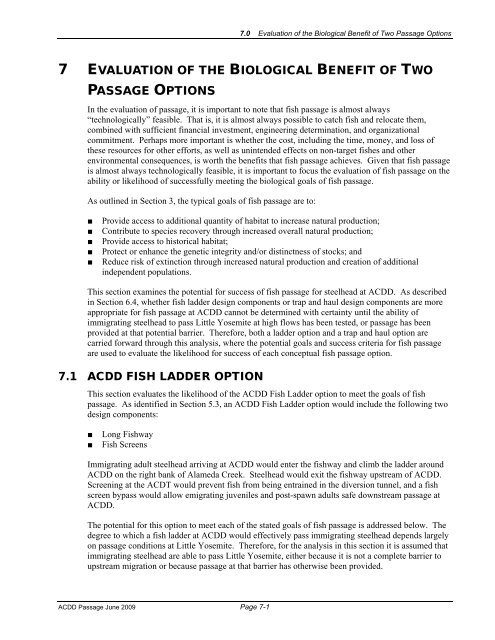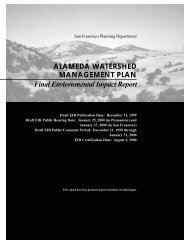Feasibility of Fish Passage at Alameda Creek Diversion Dam
Feasibility of Fish Passage at Alameda Creek Diversion Dam
Feasibility of Fish Passage at Alameda Creek Diversion Dam
Create successful ePaper yourself
Turn your PDF publications into a flip-book with our unique Google optimized e-Paper software.
7.0 Evalu<strong>at</strong>ion <strong>of</strong> the Biological Benefit <strong>of</strong> Two <strong>Passage</strong> Options7 EVALUATION OF THE BIOLOGICAL BENEFIT OF TWOPASSAGE OPTIONSIn the evalu<strong>at</strong>ion <strong>of</strong> passage, it is important to note th<strong>at</strong> fish passage is almost always“technologically” feasible. Th<strong>at</strong> is, it is almost always possible to c<strong>at</strong>ch fish and reloc<strong>at</strong>e them,combined with sufficient financial investment, engineering determin<strong>at</strong>ion, and organiz<strong>at</strong>ionalcommitment. Perhaps more important is whether the cost, including the time, money, and loss <strong>of</strong>these resources for other efforts, as well as unintended effects on non-target fishes and otherenvironmental consequences, is worth the benefits th<strong>at</strong> fish passage achieves. Given th<strong>at</strong> fish passageis almost always technologically feasible, it is important to focus the evalu<strong>at</strong>ion <strong>of</strong> fish passage on theability or likelihood <strong>of</strong> successfully meeting the biological goals <strong>of</strong> fish passage.As outlined in Section 3, the typical goals <strong>of</strong> fish passage are to:■■■■■Provide access to additional quantity <strong>of</strong> habit<strong>at</strong> to increase n<strong>at</strong>ural production;Contribute to species recovery through increased overall n<strong>at</strong>ural production;Provide access to historical habit<strong>at</strong>;Protect or enhance the genetic integrity and/or distinctness <strong>of</strong> stocks; andReduce risk <strong>of</strong> extinction through increased n<strong>at</strong>ural production and cre<strong>at</strong>ion <strong>of</strong> additionalindependent popul<strong>at</strong>ions.This section examines the potential for success <strong>of</strong> fish passage for steelhead <strong>at</strong> ACDD. As describedin Section 6.4, whether fish ladder design components or trap and haul design components are moreappropri<strong>at</strong>e for fish passage <strong>at</strong> ACDD cannot be determined with certainty until the ability <strong>of</strong>immigr<strong>at</strong>ing steelhead to pass Little Yosemite <strong>at</strong> high flows has been tested, or passage has beenprovided <strong>at</strong> th<strong>at</strong> potential barrier. Therefore, both a ladder option and a trap and haul option arecarried forward through this analysis, where the potential goals and success criteria for fish passageare used to evalu<strong>at</strong>e the likelihood for success <strong>of</strong> each conceptual fish passage option.7.1 ACDD FISH LADDER OPTIONThis section evalu<strong>at</strong>es the likelihood <strong>of</strong> the ACDD <strong>Fish</strong> Ladder option to meet the goals <strong>of</strong> fishpassage. As identified in Section 5.3, an ACDD <strong>Fish</strong> Ladder option would include the following twodesign components:■■Long <strong>Fish</strong>way<strong>Fish</strong> ScreensImmigr<strong>at</strong>ing adult steelhead arriving <strong>at</strong> ACDD would enter the fishway and climb the ladder aroundACDD on the right bank <strong>of</strong> <strong>Alameda</strong> <strong>Creek</strong>. Steelhead would exit the fishway upstream <strong>of</strong> ACDD.Screening <strong>at</strong> the ACDT would prevent fish from being entrained in the diversion tunnel, and a fishscreen bypass would allow emigr<strong>at</strong>ing juveniles and post-spawn adults safe downstream passage <strong>at</strong>ACDD.The potential for this option to meet each <strong>of</strong> the st<strong>at</strong>ed goals <strong>of</strong> fish passage is addressed below. Thedegree to which a fish ladder <strong>at</strong> ACDD would effectively pass immigr<strong>at</strong>ing steelhead depends largelyon passage conditions <strong>at</strong> Little Yosemite. Therefore, for the analysis in this section it is assumed th<strong>at</strong>immigr<strong>at</strong>ing steelhead are able to pass Little Yosemite, either because it is not a complete barrier toupstream migr<strong>at</strong>ion or because passage <strong>at</strong> th<strong>at</strong> barrier has otherwise been provided.ACDD <strong>Passage</strong> June 2009 Page 7-1








